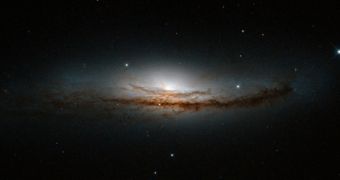Astronomers operating the NASA/ESA Hubble Space Telescope were recently able to capture an amazing new image of a nearby spiral galaxy called NGC 5793. This object is interesting both through its nature as well as through the weird structures it contains within. Additionally, a dark band of dust clouds its disk in this edge-on view collected by one of the longest-lived spacecraft in history.
NGC 5793 is a Seyfert galaxy, meaning that it belongs to one of two groups of the largest, most active galaxies in the Universe. The other group is made up of quasi-stellar radio sources, or quasars, which are basically extremely distant supermassive black holes located at the core of active galactic nuclei.
Hubble's recent target is located just 150 million light-years away, in the constellation of Libra, which is very close in astronomical terms. Astronomers were puzzled to discover that the galaxy appears to house a number of maser structures, which are areas of space that absorb energy from their environment and then re-emit it as microwaves.
The term maser is derived from laser and stands for Microwave Amplification by Stimulated Emission of Radiation. In outer space, masers usually develop in areas that support significant rates of stellar formation. Scientists now plan to conduct additional observations of NGC 5793 in a bid to learn more about the nature of Seyfert galaxies and about masers in general.

 14 DAY TRIAL //
14 DAY TRIAL //